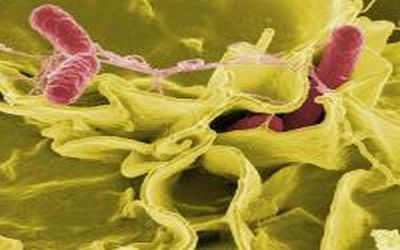Researchers Find a Way to Detect Stealthy, 'Hypervirulent' Salmonella Strains
A recent discovery of "hypervirulent" Salmonella bacteria has given UC Santa Barbara researchers Michael Mahan and Douglas Heithoff a means to potentially prevent food poisoning outbreaks from these particularly powerful strains. Their findings, in a paper titled "Intraspecies Variation in the Emergence of Hyperinfectious Bacterial Strains in Nature," have been published in the journal PLoS Pathogens.


Salmonella typhimurium (red) invades cultured human cells in this color-enhanced scanning electron micrograph.
A recent discovery of "hypervirulent" Salmonella bacteria has given UC Santa Barbara researchers Michael Mahan and Douglas Heithoff a means to potentially prevent food poisoning outbreaks from these particularly powerful strains. Their findings, in a paper titled "Intraspecies Variation in the Emergence of Hyperinfectious Bacterial Strains in Nature," have been published in the journal PLoS Pathogens.
Salmonella is the most common cause of infection, hospitalization, and death due to foodborne illness in the U.S. This burden may continue to worsen due to the emergence of new strains that would tax current health-control efforts. To address this problem, researchers sought out and found hypervirulent strains that present a potential risk to food safety and the livestock industry.
An international team of scientists which also included Robert Sinsheimer and William Shimp from UCSB; Yi Xie and Bart Weimer from UC Davis; and John House from University of Sydney, Australia conducted a global search for hypervirulent Salmonella strains. They were found among isolates derived from livestock, and rendered current vaccines obsolete.
Bacteria behave like a Trojan Horse, exposing their weapons only after initiating infection. "These strains exhibit this behavior in the extreme essentially having a '5th gear' they can switch to during infection," says Heithoff, lead author of the paper.
Â
Previous efforts to find hypervirulent strains were unsuccessful since bacteria behave much like their less-virulent cousins after environmental exposure. "The trick was to assess their virulence during infection before they switch back to a less-virulent state in the lab," says Mahan.
Now that researchers know what to look for, they are developing methods to rapidly detect and discriminate the more harmful strains from their less-virulent cousins. The strategy is aided by a special medium utilized by the researchers that forces the bacteria to reveal their weapons in the laboratory the first step in the design of therapeutics to combat them.
Humans usually get Salmonella food poisoning from eating contaminated beef, chicken, or eggs. However, animal waste can contaminate fields where fruits, nuts, and vegetables are grown, thus posing a particular health concern for vegetarians. The threat is exacerbated when these foods are not cooked. Salmonella control efforts are expensive recent estimates place this cost up to $14.6 billion annually in the U.S.
As hypervirulent strains pose a potential risk to human and animal health, mitigation efforts warrant researchers' careful attention. "Now that we have identified the problem and potential solutions we just need to get to work," Heithoff said.
This research was launched with support from The G. Harold & Leila Y. Mathers Foundation, which then leveraged additional funding from the U.S. Department of Agriculture, National Institutes of Health, U.S. Army, and Santa Barbara Cottage Hospital Research Program.
IDEA in Action: A Strategic Approach to Contamination Control
January 14th 2025Adopting IDEA—identify, define, explain, apply—streamlines contamination control. Infection control professionals can mitigate risks through prevention, intervention, and training, ensuring safer health care environments and reducing frequent contamination challenges.
Balancing Freedom and Safety: When Public Health Mandates Are Necessary
January 9th 2025Public health mandates, such as lockdowns, masking, and vaccination, balance liberty and safety, ensuring critical protections during pandemics like COVID-19 while fostering long-term survival through science.
Long-Term Chronicles: Infection Surveillance Guidance in Long-Term Care Facilities
January 8th 2025Antibiotic stewardship in long-term care facilities relies on McGeer and Loeb criteria to guide infection surveillance and appropriate prescribing, ensuring better outcomes for residents and reducing resistance.
Considering Avian Flu: World Health Organization Expert Warns Against Raw Milk
January 6th 2025Drinking raw milk poses risks of disease transmission, especially with H5N1 outbreaks. Expert Richard J. Webby, PhD, advises against raw cow or goat milk consumption due to its unpredictable and significant risks.